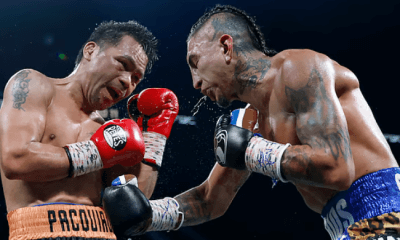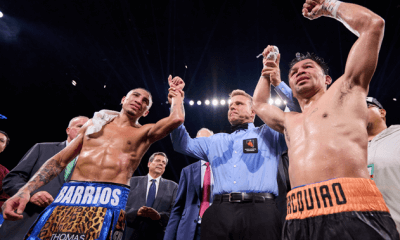Articles of 2007
Golden Gloves, Cradle of Champions
The New York City Daily News Golden Gloves tournament kicked off its 80th year at the Copacabana nightclub in midtown Manhattan on January 24. Not surprisingly, there was a host of former champions in attendance.
Included among them were Riddick Bowe, Michael Bentt, Gerry Cooney, Carl “The Truth” Williams, Mark Breland and Juan LaPorte. Competing in separate bouts on opening night were two recently crowned champions, Danny Jacobs and Will Rosinsky, both of whom are considered frontrunners to make the 2008 Olympic team.
A few weeks earlier a wonderful photo/text book was released by Sports Publishing, LLC. Written by Daily News reporter Bill Farrell, who has been covering the tournament for many years, the book is called “Cradle of Champions, 80 Years of New York Daily News Golden Gloves.” With a foreword by Bert Randolph Sugar, it chronicles the storied history of the tournament from its inception in 1927 until the present.
The Golden Gloves was the brainstorm of Daily News Sports Editor Paul Gallico, who had a passion for amateur boxing and believed the tournament would be as successful a promotion for the newspaper as the then wildly popular Silver Skates Derby. The latter was an annual skating tournament that had been run by the paper for five years.
In order to avoid mismatches, Gallico created the sub-novice division for beginners and the open division for more seasoned boxers. Within days of the competition being announced, more than 1,000 application entries were piled on Gallico’s desk. All told, 1,200 boxers of varied skill levels competed in the first year. Because there were so many more applicants than expected, an additional 16 venues had to be found to host the fights.
On the night of the finals, 21,594 fans were on hand. Nearly 10,000 people had to be turned away. To this day, the Golden Gloves finals, which are held over two nights at Madison Square Garden, are guaranteed sellouts.
Over the following decades, the tournament has just gotten bigger and bigger. The list of Golden Gloves champions who went on to win world titles is impressive. Included among them are Bob Olin, Lou Salica, Gus Lesnevich, Phil Terranova, Sugar Ray Robinson, Emile Griffith, Floyd Patterson, Jose Torres, Vito Antuofermo, Eddie Gregory, who later changed his last name to Mustafa Muhammad, LaPorte, Davey Moore. Hector Camacho, Mark Breland, Tracy Harris Patterson, Kevin Kelley, Bentt, Bowe, Aaron Davis, Junior Jones, Lou Delvalle, Lonnie Bradley, Zab Judah, Ivan Calderon, Travis Simms, and Luis Collazo.
Some of them, as well as others, have represented the United States in Olympic competition. Patterson, Breland and Howard Davis won Olympic gold. Salica, Torres and Bowe copped Olympic silver. The other Olympians are Edson Brown and Nick Spanakos, the latter of whom roomed with Cassius Clay at the 1960 Games in Rome.
Through the use of whimsical reporting and an abundance of terrific black and white photos, Farrell eloquently tells the tale of one of America’s premier athletic competitions.
There are rare and sensational photos of fans listening excitedly to Golden Gloves action on a radio, as well as the 1933 Inter-City team returning home by train from the tournament in Chicago.
There is a youthful Lesnevich jumping rope at the St. Nicholas Gym, Hollywood starlet Mae West attending the 1939 finals, “Death” Robinson, who later took on the more genteel moniker of “Sugar Ray,” blasting out several opponents in 1940, Rocco Marchegiano (later known as Rocky Marciano) losing a decision to Coley Wallace, and Johnny Saxton punching his way to the head of the 1948 tournament.
There are photos of the Spanakos brothers, who are quite possibly the most accomplished amateurs in history, New York favorite Jimmy Archer, the extremely powerful Griffith knocking down one Osvaldo Marcano, who came back to win the fight, and Tommy Gallagher, who is currently a trainer on “The Contender” reality television series, knocking down Dennis Kelly in the second round in 1959. Gallagher, who now has a shaved head, has a glare on his face and his pompadour is barely mussed.
There are great shots of a young Cassius Clay competing in the 1960 Inter-City tournament, Chuck Wepner landing a right hand to the head of James Sullivan in the 1964 finals, a powerhouse named Forest Ward stopping Tom Connelly, Mustafa Muhammad and Antuofermo mixing it up in the 1971 finals, Kevin Rooney beating a West Point Cadet, and Cooney winning the heavyweight open in 1976.
Farrell takes us right through the eighties and into the new millennium, where women are now a fixture in the tournament.
It is obvious that this book was truly a labor of love for Farrell. There are only two things that I found fault with. In the appendix, there is no chronological listing of all of the Golden Gloves champions. The only ones listed are those that went on to become Olympians or professional world champions or world champions from the Chicago Inter-City team that boxed at Madison Square Garden.
And while Farrell quotes numerous champions such as Breland, Gallagher, Bentt, Wepner, Kelley, Jones and Antuofermo on what the tournament meant to them, it would have been nice to quote some of the scores of competitors who never won the coveted gloves.
Peter Wood, for example, made it to the middleweight semi-finals of the 1971 tournament. Now a high school English teacher in his early fifties, he has extensively written about his Gloves experience.
Besides numerous articles on this website, his first book “To Swallow a Toad,” chronicled his quest to make it to the finals. That book has been updated and will be re-released in February by Ringside Books under the title “Confessions of a Fighter: Battling Through the Golden Gloves.”
A new book by Wood, “A Clenched Fist: The Making of a Golden Gloves Champion,” is also due to be released in February. Wood describes it as a blend between “Rocky” and “Up the Down Staircase,” and says it follows two teenagers as they try to navigate the merciless gauntlet of training, sparring and proving themselves in the ring.
Even though Wood never won a Gloves title, he more than proved himself in the tournament. In his last fight before losing a squeaker in the semis, he beat a tall and lanky but extremely powerful opponent with a high Afro named Walter Johnson.
Wood was later told by the late Vic Zimet that Johnson held a win over Harold Weston. To say Wood was overmatched on paper would have been an understatement.
On that evening, however, Wood was not to be denied. Fighting tactically but ferociously, he knocked Johnson cold with what could arguably be one of the best single left hooks ever thrown in the tournament.
Believe me, I wouldn’t be writing this if I didn’t see it. Just a few weeks ago, boxing collector and historian Ray McCormack showed me a tape of that fight. I still find it hard to believe that my writing colleague, who seems so much more academically than athletically inclined, was capable of such an explosive performance.
That ambiguity is what makes amateur boxing—especially Golden Gloves competition—so great. The knockout of Johnson was a seminal moment in Wood’s life. It helped transform what had been an extremely angry, misguided and troubled teenager into a sensible and introspective adult with a lot to offer the students who are lucky enough to have him for a teacher.
Although there was not nearly enough room for Farrell to chronicle all of the near-misses, also-rans, semi-finalists and finalists who did not go home with the gold, this splendid book is as much for them as it is for the champions.
“The Golden Gloves changed my life,” said Wood, who is inadvertently speaking for thousands of others as well. “It gave me a healthy outlet for my anger. Without boxing at that time in my life, I hate to think of what might have become of me.”
“Cradle of Champions” can be purchased on Amazon.com and BarnesandNoble.com or in any bookstore.
Wood’s books can also be purchased on those websites, in bookstores or through the publisher, which can be reached at: RingsideBooks.com.
-

 Featured Articles4 weeks ago
Featured Articles4 weeks agoResults and Recaps from New York Where Taylor Edged Serrano Once Again
-

 Featured Articles2 weeks ago
Featured Articles2 weeks agoThe Hauser Report: Zayas-Garcia, Pacquiao, Usyk, and the NYSAC
-

 Featured Articles5 days ago
Featured Articles5 days agoOscar Duarte and Regis Prograis Prevail on an Action-Packed Fight Card in Chicago
-

 Featured Articles4 weeks ago
Featured Articles4 weeks agoResults and Recaps from NYC where Hamzah Sheeraz was Spectacular
-

 Featured Articles3 weeks ago
Featured Articles3 weeks agoManny Pacquiao and Mario Barrios Fight to a Draw; Fundora stops Tim Tszyu
-

 Featured Articles4 weeks ago
Featured Articles4 weeks agoPhiladelphia Welterweight Gil Turner, a Phenom, Now Rests in an Unmarked Grave
-

 Featured Articles2 weeks ago
Featured Articles2 weeks agoArne’s Almanac: Pacquiao-Barrios Redux
-

 Featured Articles1 week ago
Featured Articles1 week agoRemembering Dwight Muhammad Qawi (1953-2025) and his Triumphant Return to Prison













